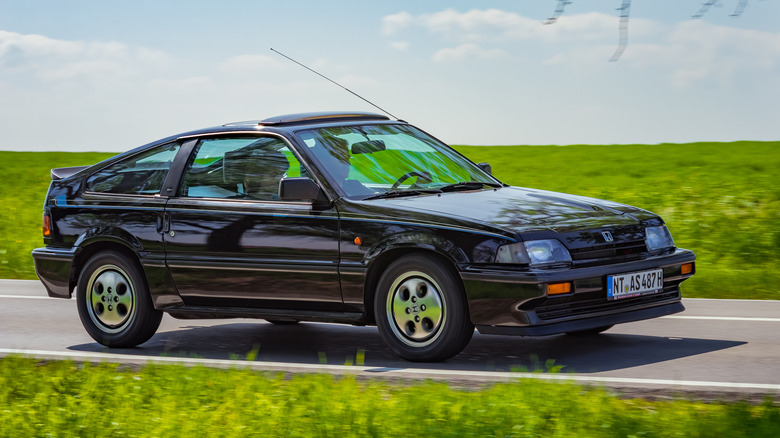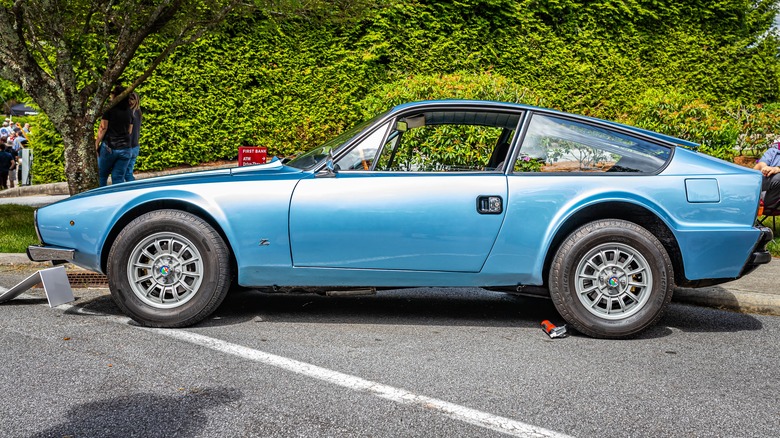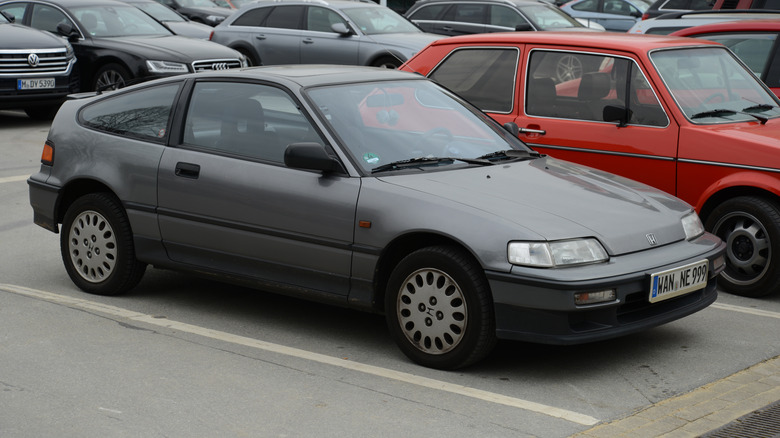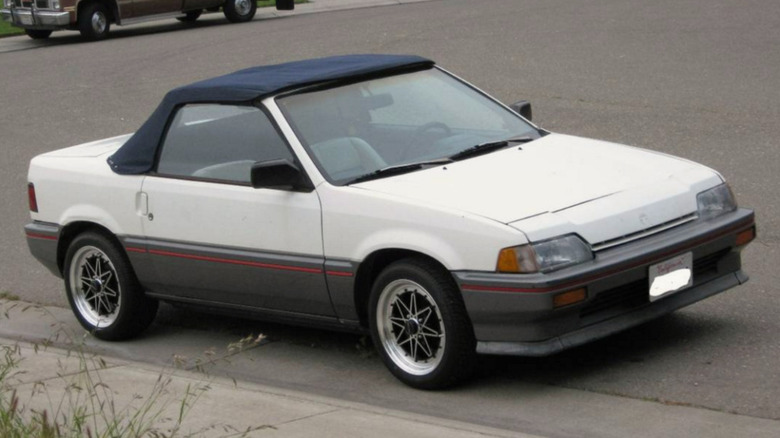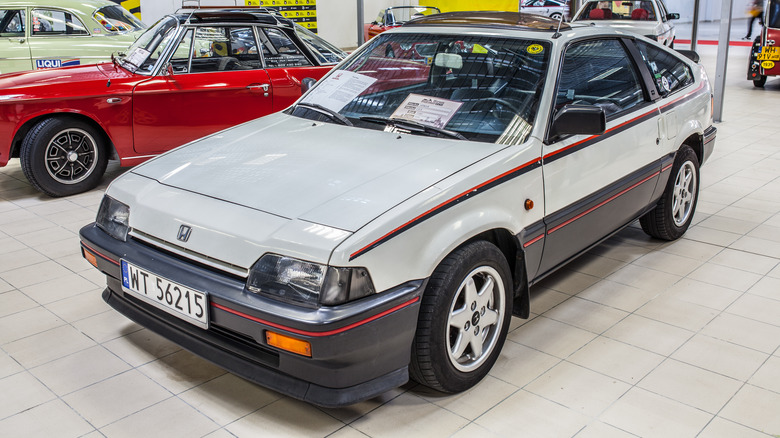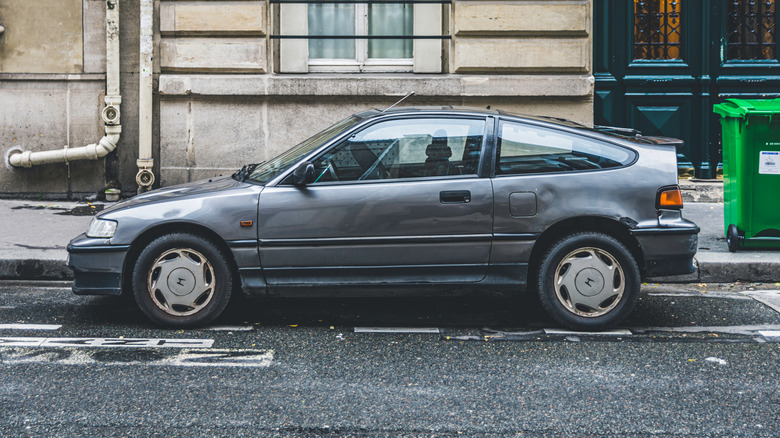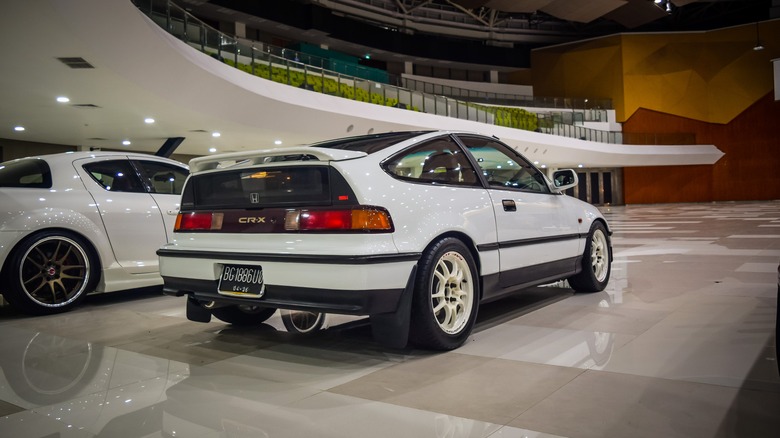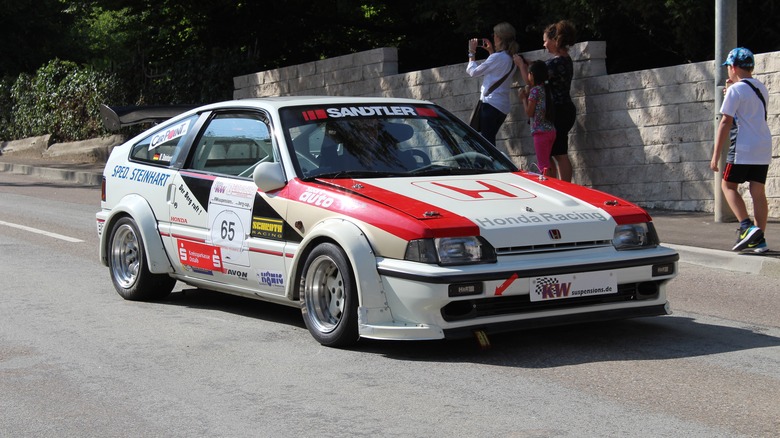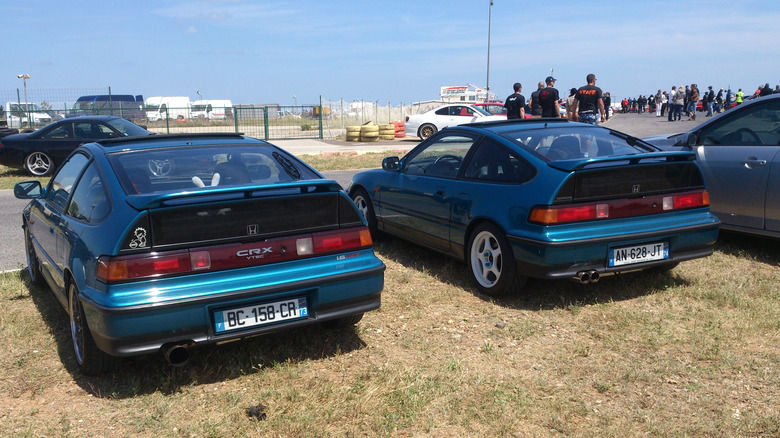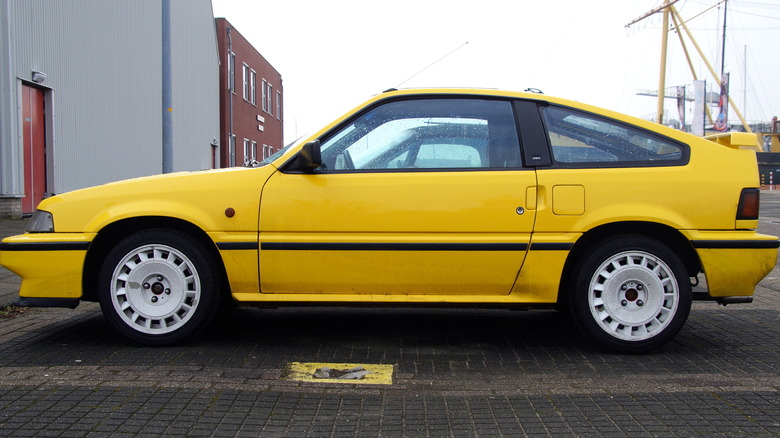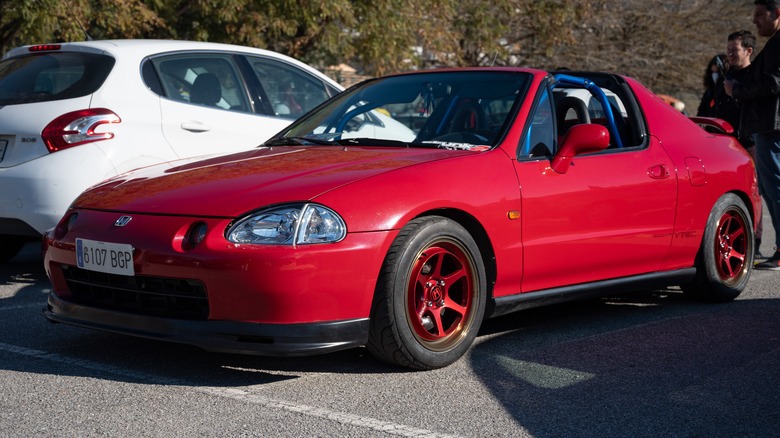The 10 Coolest Features Of The Honda CRX
As modern cars become heavier, faster, and more complicated, many enthusiasts yearn for the days when things were simpler. They would argue that these simpler cars provided driving thrills that simply aren't matched today, allowing for a purer driving experience than anything produced this century. One car that sums up this argument is the Honda CRX, the Civic-based sports car that might not have packed a lot of power, but was up there with the best of them when it came to usable driver enjoyment.
Being a Honda, the CRX was still very much a practical car, but its light curb weight, excellent handling, and no-frills setup ticked all the right boxes for enthusiasts. Although the CRX sold well during its production run, the oldest examples are now nearly 40 years old, and inevitably that means that the supply of examples in good condition is drying up. So, is now the time to snap one up while they're still affordable? Let's take a look back and see exactly what made the CRX such an enthusiast's favorite.
Zagato-inspired styling
Perhaps the most immediately distinctive feature of the CRX is its unique styling. Except, it isn't that unique at all — in fact, many of the styling cues that made the CRX such an icon were actually borrowed from an obscure Zagato-designed Alfa Romeo that had debuted a decade earlier. The 1970 Alfa Romeo Junior Zagato was a minor hit for the Italian brand when it was released, being built to cater to younger buyers who wanted a sporty-yet-compact daily driver.
The CRX catered to the same demographic, and when you look at the two cars side-by-side it's easy to see the similarities in their shape. This was no accident either, as the designer of the CRX owned a Junior Zagato at the time, according to Curbside Classic. It wasn't identical by any means: Honda's effort was boxier, with simplified lines and two-tone body panels that brought it in line with the brand's other products at the time. Even so, it's safe to assume that the CRX would not have ended up looking the way that it did without some heavy inspiration from the little Italian car.
Either a 2-seater or a 2 2
CRXs built for the American market were sold as two-seaters, but in Europe and Japan, a small set of rear seats were also fitted (via Supercar Nostalgia). These rear seats could fold down to provide extra space for luggage, and given the car's sloping roof, it's not like they could have comfortably fitted adults anyway. That wasn't the only difference between the American CRX and its global cousins though, as the USDM car also dropped the flip-up headlight "eyebrows" and couldn't be optioned with digital instruments.
Unfortunately for American buyers, federal regulations also meant that the CRX lost some power, only producing 60 horsepower in base form as opposed to the JDM car's 76 horsepower. Perhaps this is the reason why Honda chose to remove the rear seats — if the engine's output had to be decreased, at least being a two-seater would make the car appear just as sporty as its JDM cousins. This all matters less today anyway, since every first- and second-generation CRX is now able to be imported legally under the 25-year rule.
Convertible version available for America
While the Europeans and the Japanese seemingly got a better deal when it came to engine power, the American market did boast one thing the rest of the world never got: a CRX convertible. It wasn't built by Honda, but rather by the California-based R. Straman Company, which also specializes in converting Ferrari Daytonas from Berlinettas into Spyders (via Supercar Nostalgia). Each converted CRX was fitted with a canvas roof and a reinforced body shell to compensate for chopping the roof off.
The finished car was then shipped back to Honda dealers and sold through their official network. The conversion process was costly, with these drop-tops reportedly costing around 50% more than a regular fixed-roof CRX. As a result, they're exceedingly rare, with only 310 examples ever built out of a total run of 220,000 CRXs. It's not known how many of that original run survive today and suffice it to say, they're very rarely seen for sale on the open market. One example did appear on Bring A Trailer in 2017, although it's not known what it sold for.
Lightweight plastic body panels
The idea of plastic body panels may hardly be an exotic one now, but back in 1984 when the first CRX hit showrooms, the idea was considerably more unusual. Hagerty reports that around 40% of the car's body panels were made of plastic, all made in-house by Honda at its Suzuka plant. The use of plastic caused concerns over sustainability among Honda's management, with R&D Director Hidekuni Hagiwara being particularly keen on finding a way to reuse the panels if possible.
He saw them as being potentially more recyclable than metal, although it would turn out that was largely untrue. Still, the plastic panels helped keep the car's weight down to a minimum, and that ended up being a key factor in its appeal among enthusiasts. The plastic body panels remained largely unchanged throughout the production of the first- and second-generation cars, although from 1986, those panels could be painted the same color as the body to make them less noticeable.
Fuel-sipping HF
The base-spec CRX HF or "high fuel" variant was not only sporty and fun to drive, but it was also groundbreakingly economical. It reportedly became the first car to break the 50 mpg barrier in the EPA's testing cycle, a remarkable achievement given that this was a car built primarily to be sporty rather than simply efficient. The first-generation HF, built from 1984-1987, made just 60 horsepower. For the second-gen car, built between 1988 and 1991, that figure was upped to a slightly better 72 horsepower.
It was still way short of what American sports cars could produce, and even other Japanese sports cars eclipsed it, but none were anywhere near as fuel-sipping. Indeed, even most modern gas-powered cars without a hybrid system would struggle to come close to matching that figure. As well as being friendlier to the environment, that meant the CRX's running costs were unbeatably low, what with Honda's famed reliability and unprecedented economy.
Sportier Si
In case the regular CRX wasn't quite fast enough, Honda launched the Si in the American market in 1985 (via Road and Track). Like the other variants in the lineup, the U.S.-market Si differed from its European and Japanese cousins, but it was still a significant improvement over the base car. It made 91 horses and featured a five-speed manual transmission, which combined with its light curb weight, made it a ton of fun on the backroads. It also came with several nice-to-have features including a sunroof and rear wipers as standard (via Hagerty).
It was this top-spec Si that became the biggest hit in the U.S. market, especially since it occupied a place in the market that almost nothing else did at the time. At $7,999, it was $1,000 more expensive than a base-spec CRX, but still significantly cheaper than either a Toyota MR2 or a Pontiac Fiero. It was also arguably livelier to drive than either of them, in part thanks to its stiffer suspension. The launch of the Si was in some ways the final puzzle piece to click into place for the CRX, and as a result, it has remained the most desirable variant for collectors today.
Large aftermarket
Like many Japanese cars from its era, the CRX's affordability combined with its usefulness as a daily driver meant that it became the go-to car for plenty of cash-strapped young enthusiasts. Often, the car's unimpressive stock power output wasn't enough for them, and as a result, an extensive aftermarket sprung up around the car in the years after its launch. Since it was based on the underpinnings of the Civic, which already had a large aftermarket, it didn't take long for a range of performance-enhancing kits to be developed. Alongside them, visual modifications like body kits became more common.
As the CRX has evolved from an affordable daily driver to a beloved Japanese icon, the complexity and quality of builds have gone up. Many highly modified examples today are the product of years of work, or in some cases, old family cars that have been given a new lease of life as show-ready projects.
Rising resale values
The percentage of remaining stock cars that end up being modified will likely decrease as the CRX gets more expensive to buy in the first place, and there's no doubt that it is indeed getting more expensive. Looking at the sales data from Bring A Trailer shows a clear upward trend in resale prices, with the most valuable examples being those in pristine, original condition. During the first year of recorded data in 2018, the most expensive CRX sold on the site was a 52,000-mile Si that went for $15,250, but fast forward to 2022, and a 12,000-mile Si had sold for $40,000, over two-and-a-half times the price.
Not every CRX will cost as much as a new car to buy, but the days when they could be picked up for a couple of thousand dollars seem to be long gone, at least if you want a car in running condition. The cheapest example sold on Bring A Trailer in 2022 fetched a little under $8,000 and had 122,000 miles on the clock. So, it's still possible to buy one for four figures, but bargain examples like this are becoming few and far between.
A cursed paint code
One of the strangest bits of folklore surrounding the CRX is the supposed "cursed color," which could cause the car's owner all manner of issues if the story is to be believed. According to Car Bibles, the color in question is Y-49, more commonly known as Barbados Yellow. It allegedly made workers at the Honda factory ill due to its toxicity, and some owners reported that their yellow cars kept getting into strange accidents, including animals running into the car and uncharacteristic mechanical problems.
A few CRX owners on forums have even claimed that just driving one can cause people to crash uncontrollably and total their cars, or mysteriously break down for no reason in the middle of nowhere. Now, obviously, it's worth taking all these stories with a grain of salt (or a truckload of it), especially since Car Bibles reports that most of the rumors came from an old, poorly-formatted site that shut down while the writers were working on the story. Even so, it's amusing that someone would even go to the trouble of maintaining a decades-old conspiracy theory about a practical Japanese sports compact, whatever their motives might be. It's worth noting that Car Bibles did contact Honda about the Y-49 curse, and despite their best efforts, the company's PR reps reported that no one at the firm had even heard of the supposed curse before.
A formidable legacy
Cursed or not, the CRX left behind a legacy among owners and fans that has persisted to this day, and gave its successor huge shoes to fill upon its departure. That successor was the CRX Del Sol, which was technically the third-generation CRX but was so different that it's widely considered to be an entirely separate car. Honda even dropped the "CRX" from the name entirely after a few years as it was seen to be causing negative publicity. Although the Del Sol was arguably a good practical sports car in its own right, being burdened with the task of succeeding the CRX meant that it never enjoyed the same stellar reputation among enthusiasts as its predecessor.
That mixed reputation has helped keep resale prices relatively affordable today, even while many of the car's contemporaries have shot up in price as nostalgia for Japanese classics reaches record levels. The original CRX itself is hardly the enthusiast-spec bargain that it used to be, and in a few years' time, there's a good chance that it might have ballooned in price to push it out of the reach of budget-conscious enthusiasts altogether.
